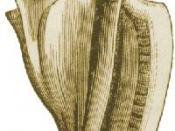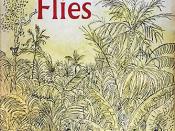In the human world, there is a subtle line between civilization and savagery. Many would like to think that they would never cross this line, but even the most wary can be pushed off the their platform of society and organization, into a world of savagery and chaos. In Lord of the Flies, by William Golding, a group of British boys are stranded on an island with no adults after their plan crashes. At first, the boys attempt to create a somewhat organized environment, but, over time, they become a barbaric mob of savages. This book is a novel of descent, a gradual curve from attempted maturity and hopes of survival, to mass hysteria, dark impulses, and frenzied bloodlust. Then, towards the end of the book, the mood lifts slightly, leading the characters to revelations, regret, and the loss of innocence. This path of descent is clearly represented by several key events - the finding of the conch and failed attempt at civilization, the killing of Simon, an altruistic boy, and the rescue of the boys.
At the beginning of the book, Ralph, the main character, and Piggy, a fat, intelligent boy, find a conch shell. Ralph blows into the conch and calls an assembly with all the boys on the island. There, they vote Ralph to be chief. Then Ralph and Jack, an arrogant redhead, start to create an organized society, using the conch as a device of authority. Anyone who has the conch has a right to speak and voice his opinion. Bonding together in an imitation of society, the boys organize themselves into their own interpretation of civilization. "We'll have rules," says Jack. "Lots of rules! Then when anyone breaks 'em -" (33). This quote is significant because it shows Jack's willingness to establish order. It...


